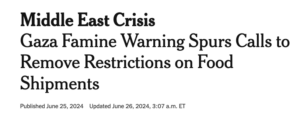It’s embarrassing to admit a mistake. But it’s worse to try and hide it.
Sadly, media outlets opted for the latter in their coverage of a revised report that contradicted their narrative on Gaza “famine.”
The June 25 report, by the Integrated Food Security Phase Classification (IPC), included two main points:
- Contrary to the IPC’s widely-covered estimates from March 18, the report stated that “the available evidence does not indicate that famine is currently occurring” in northern Gaza.
- A “high risk” of famine persists across the whole of the Gaza Strip, as long as conflict continues.
Any journalist reading the report should have immediately noticed that its authors have buried the first point — which is new and proves that they were wrong — while leading with the second point, which is repetitive and speculative.
But instead of critically calling out their source and reporting what’s new in the report, media outlets were happy to copy-paste it, effectively burying, distorting or altogether omitting the news that would have embarrassed them and the IPC alike for spreading false information.
Related Reading: Media Fail to Report Officials Got It Wrong Over Gaza “Famine”
Omission and Distortion
Some background: In March, media headlines were quick to parrot the IPC’s “famine” forecast, and in early June they ignored the monitor’s admission of several flaws in its original data-gathering.
Ideally, these journalistic sins should have been corrected now, with headlines about the revised report that look like this:
- Global monitor announces no evidence of Gaza famine
- Global monitor lowers estimate of Gazans facing “catastrophic” hunger from 1.1 million to 495,000
- IPC admits March report on Gaza famine was faulty
- Aid deliveries alleviated hunger conditions in Gaza – report
Instead, media outlets buried this information, as well as omitted or distorted it, to hide the truth from their audience.
CNN buried the no-famine point in the 10th paragraph of its text story. On Instagram, it’s been completely omitted with a reframed headline:
The report stated its previous assumptions were wrong on the amount of food entering Gaza and said, “In this context, the available evidence does not indicate that Famine is currently occurring.”
But that would’ve ruined @CNN‘s narrative… pic.twitter.com/8sNznK2Rkx
— HonestReporting (@HonestReporting) June 26, 2024
The Guardian went further, not only burying the news (in the 3rd paragraph), but distorting it with an agenda-driven headline:

The British paper also had no qualms about publishing an op-ed that falsely claims Israel is deliberately starving Gazans the same way the Nazis starved Jews in the Holocaust.
“The idea that we can somehow put what is happening in Gaza at a distant remove from the history of the Warsaw ghetto is grotesque.”
No, @guardian, what’s grotesque is publishing an op-ed that falsely claims Israel is deliberately starving Gazans the same way the Nazis starved… pic.twitter.com/MCEqTKnYp4
— HonestReporting (@HonestReporting) June 26, 2024
Distortion also plagued The New York Times report, which framed the entire story with comments from aid groups, and avoided mentioning the no-famine point by stating (in the 3rd paragraph) that the IPC has “stopped short of saying that a famine had begun.”

The BBC, The Telegraph and The Independent almost copy-pasted the IPC report verbatim, with headlines about the risk of famine:



These three outlets also uncritically parroted the report’s assessment that almost half a million Gazans now face “catastrophic” hunger — without mentioning that it’s down from the original estimate of 1.1 million.
Media Cop Out
Admittedly, news outlets must cover what bodies like the IPC report. And it’s true that the report sneakily started with the words: “A high risk of famine persists across the whole Gaza Strip.”
But journalists should read between the lines, understand the background, and not just take the IPC’s word as gospel, especially if its previous reports have been proven wrong.
Unfortunately, media outlets avoided this inconvenience and chose to perpetuate the false famine narrative.
After all, it’s an easy cop-out that hides their own faults of parroting unreliable sources.
Liked this article? Follow HonestReporting on Twitter, Facebook, Instagram and TikTok to see even more posts and videos debunking news bias and smears, as well as other content explaining what’s really going on in Israel and the region. Get updates direct to your phone. Join our WhatsApp and Telegram channels!
Image Credits: Abed Rahim Khatib via Flash90/Atia Mohammed via Flash90/Majdi Fathi via TPS


